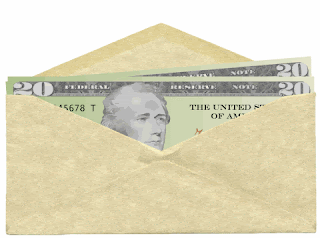A Simple Solution of the Envelope Exchange Paradox
We
are shown two envelopes: One envelope contains twice as much money as
the other.
Having
chosen one envelope, before inspecting it, we are given a chance to
take the other envelope instead.
It
would appear that it is to our advantage to switch envelopes if
we
reason as follows:
1.
Let’s suppose that the amount in our selected envelope is $20.
2.
The probability that it is the smaller amount is 50%, and that it is
the larger amount is also 50%.
3.
The other envelope may contain either twice as much ($40) or
half as much ($10).
4.
If we switch envelope, then we could gain $20, or lose $10. Thus we
are better off by switching envelopes.
We
know that the above reasoning is wrong, because after switching
envelopes we could use the same reasoning to switch the envelopes
again!
So,
how do we solve this apparent paradox?
You
may want to think about it, before reading any further.
A
Simple Solution:
We
do not know the amount in
our
selected envelope. However, we know that the total amount in both
envelopes is fixed and pre-established.
We
can suppose that our selected envelope contains any amount (e.g.
$20).
This
implies the total amount for the two envelopes would be either
($20 + $10 = $30) or ($20 + $40 = $60).
The
key point is that the two totals cannot be true at the same time.
Thus
each hypothetical scenario must be analyzed separately, and not as in
points 3. and 4. above.
In
the first scenario (Total = $30), our
supposition that our selected envelope contains $20 would imply that
the other envelope contains $10. However, it is equally probable that
the opposite is true: our selected envelope could contain only $10
and the other $20.
In
both cases, by switching the envelope, we may gain or we may lose
$10.
Similarly,
in the second scenario (Total = $60), our
supposition that our selected envelope contains $20 would imply that
the other envelope contains $40. However, it is equally probable that
the opposite is true: our selected envelope could contain $40 and the
other $20.
In
both cases, by switching the envelope, we may gain or we may lose
$20.
Thus,
in both scenarios, there is no probabilistic advantage in switching
envelopes.



Comments
Post a Comment